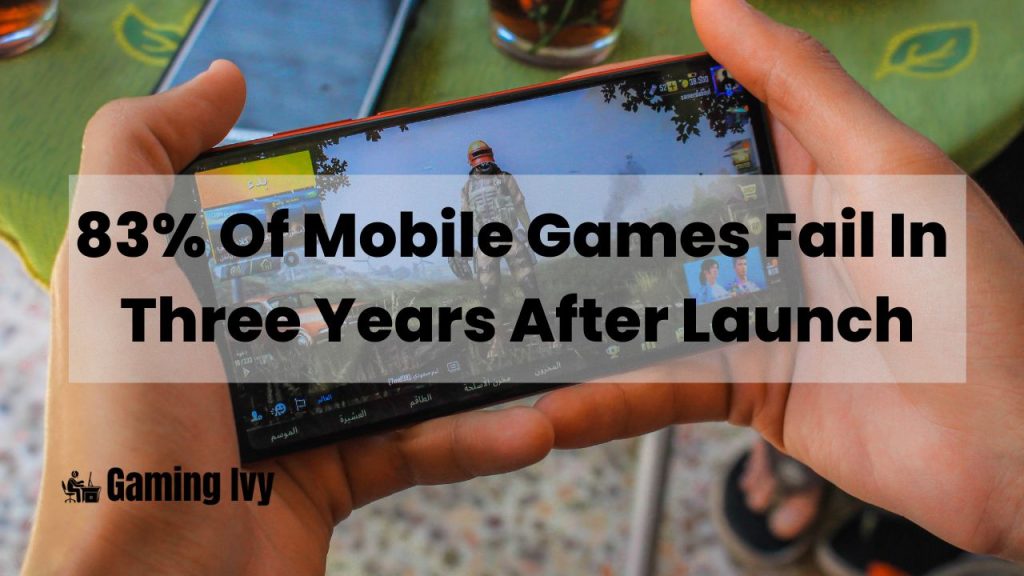83% Of Mobile Games Fail In Three Years After Launch
One of the primary reasons for this high failure rate is the sheer number of mobile games available in the market. With so many games to choose from, it’s difficult for new games to stand out and attract players.
Additionally, many mobile games are free-to-play, which means that developers need to rely on in-app purchases to generate revenue. This can be a challenging business model, as players are often hesitant to spend money on virtual items.

Another reason for the high failure rate is the lack of quality control in the mobile gaming industry. Unlike console games, which are subject to strict quality control standards, mobile games are often released with bugs and glitches that can negatively impact the player experience. This can lead to poor reviews and low ratings, which can hurt a game’s chances of success.
According to a report by, 83% of mobile games fail within three years after launch. This is a staggering number, and it’s important to understand the reasons behind this failure rate.
One of the primary reasons for this high failure rate is the sheer number of mobile games available in the market. With so many games to choose from, it’s difficult for new games to stand out and attract players. Additionally, many mobile games are free-to-play, which means that developers need to rely on in-app purchases to generate revenue. This can be a challenging business model, as players are often hesitant to spend money on virtual items.
Another reason for the high failure rate is the lack of quality control in the mobile gaming industry. Unlike console games, which are subject to strict quality control standards, mobile games are often released with bugs and glitches that can negatively impact the player experience. This can lead to poor reviews and low ratings, which can hurt a game’s chances of success.
Finally, the mobile gaming industry is constantly evolving, with new trends and technologies emerging all the time. Developers need to stay up-to-date with these changes and adapt their games accordingly. Failure to do so can result in a game that feels outdated and unappealing to players.
To provide more context, the mobile gaming industry has grown rapidly over the past decade. In 2020, the global mobile gaming market was valued at $77.2 billion, and it is expected to grow to $98 billion by 2024. This growth has been driven by the increasing popularity of smartphones and tablets, which have made mobile gaming more accessible than ever before.
In terms of concrete examples, one mobile game that failed to gain traction was “Draw Something.” The game was released in 2012 and quickly became popular, but its popularity declined just as quickly. One of the reasons for this decline was the lack of updates and new content, which made the game feel stale and uninteresting.
Table of Contents
What are some of the reasons that mobile games fail within three years of launch?
A study conducted by Abdulrahman Kerim and Burkay Genç found that in-app purchases (IAPs), genre, number of supported languages, developer profile, and release month have a clear effect on the success of a mobile game.
Another common reason for failure is the inability to retain users, which can be attributed to factors such as poor user experience, lack of updates, and competition from other games.
How do mobile game developers determine whether a game will be successful or not?
Developers use a variety of methods to predict the success of a mobile game, including market research, user testing, and analysis of similar games. They also consider factors such as the game’s genre, target audience, monetization strategy, and platform.
Are there any mobile games that have been successful for more than three years?
Yes, there are many mobile games that have been successful for more than three years. Some examples include Candy Crush Saga, Clash of Clans, and Pokémon Go.
What are some of the most common monetization strategies used by mobile game developers?
Some of the most common monetization strategies used by mobile game developers include in-app purchases, advertising, and subscription models.
In-app purchases are the most popular monetization method, with games offering virtual goods, currency, and other items for purchase.
How do mobile game developers balance the need to generate revenue with the desire to create engaging and enjoyable games?
Developers must balance the need to generate revenue with the desire to create engaging and enjoyable games by implementing monetization strategies that do not detract from the user experience. This can be achieved by offering optional in-app purchases, displaying non-intrusive ads, and providing rewards for watching ads.
Developers must also ensure that the game is fun and engaging, as this is the key to retaining users and generating revenue over the long term.
Why did My First Android Game fail? [Quick 5 Point]
Here are some possible reasons:
Poor User Experience
If your game is difficult to navigate or has a confusing interface, users may quickly lose interest and uninstall it. Consider conducting user testing to identify areas for improvement.
Lack of Marketing
Even if your game is well-designed, it can be difficult to attract users without effective marketing. Consider promoting your game on social media, app review sites, and other relevant platforms.
Technical Issues
Bugs, crashes, and other technical issues can frustrate users and lead to negative reviews. Make sure to thoroughly test your game before releasing it and address any issues promptly.
Competition
The mobile gaming market is highly competitive, and it can be difficult to stand out among the thousands of other games available. Consider researching your competitors and identifying ways to differentiate your game.
Monetization Strategy
If your game is free, you may need to rely on ads or in-app purchases to generate revenue. However, if these strategies are too intrusive or difficult to use, users may be turned off. Consider experimenting with different monetization models to find the right balance.
In conclusion, the high failure rate of mobile games is a complex issue that can be attributed to a variety of factors. While there is no guaranteed formula for success, developers can increase their chances of success by focusing on quality, staying up-to-date with industry trends, and creating games that stand out from the crowd.



